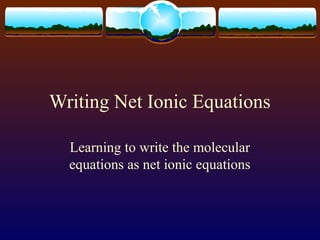
Writing net ionic equations
- 1. Writing Net Ionic Equations Learning to write the molecular equations as net ionic equations
- 2. Rules for Writing Net Ionic Equations Write weak electrolytes such as slightly soluble salts, weak acids, weak bases, gases, organic compounds, water, and complex ions as molecules. Write strong electrolytes such as soluble salts, strong acids and strong bases as ions. Cancel spectator ions (ions that are the same as reactants and products) from the equation.
- 3. Identifying the Weak Electrolytes If a reactant or product is a salt (product of acid + base reaction), check the solubility rules. Remember that all sodium salts, potassium salts, ammonium salts and nitrate salts are soluble. If a reactant or product is an acid (forms H+ in water) If a reactant or product is a base (forms OH− in water)
- 4. Other Weak Electrolytes or Nonelectrolytes Common gases are usually oxides such as CO2, H2O, SO2, SO3, NO, NO2, etc. Other common gases are the diatomic molecules such as H2, N2, O2, etc. Organic compounds (compounds that contain carbon) are usually nonelectrolytes. Water is the most common weak electrolyte. Complex ions are also weak electrolytes.
- 5. Other Information Remember that metals in their solid state are not ions and do not have charges. Most oxides are written as molecules. Write a (s) behind insoluble salts and write a (g) behind gases. Reactions that do not form a weak electrolyte or nonelectrolyte will be all spectator ions since there is no driving force for the reaction.
- 6. First Example Pb(NO3)2 + Na2S → Write the balanced equation with the predicted products. Pb(NO3)2 + Na2S → PbS + 2NaNO3 Look up the solubilities of each of the salts in the equation. Pb(NO3)2(aq)+ Na2S(aq) → PbS(s) + 2NaNO3(aq) Remember that all sodium and all nitrate salts are soluble. Put a (s) for slightly soluble salts. Now write the equation ionically. Pb2+ + 2NO3 − + 2Na+ + S2- → PbS(s) + 2Na+ + 2NO3 − Note that subscripts (except those in polyatomic ions) are brought out front when the compound is written ionically. Write the net ionic equation. Pb2+ + S2- → PbS(s) Remove all ions that are the same on the reactants and products side.
- 7. Second Example NaC2H3O2 + HCl → Write the balanced equation with the predicted products. NaC2H3O2 + HCl → NaCl + HC2H3O2 Look up the solubilities of each of the salts and the strengths of each of the acids. NaC2H3O2(aq) + HCl(aq) → NaCl (aq) + HC2H3O2 Remember that all sodium salts are soluble. Don’t put an (aq) for weak acids. Now write the equation ionically. Na+ + C2H3O2 − + H+ + Cl− → Na+ + Cl− + HC2H3O2 Note that subscripts of polyatomic ions are not brought out front when the compound is written ionically. Write the net ionic equation. H+ + C2H3O2 − → HC2H3O2 Remove all ions that are the same on the reactants and products side.
- 8. Third Example K + H2O → Write the balanced equation with the predicted products. 2K + 2H2O → 2ΚOH + H2 Look up the solubility or strength of the base. 2K(s) + 2H2O(l ) → 2KOH(aq) + H2(g) Remember that K is metal not an ion, KOH is a strong base, and water is a weak electrolyte. Now write the equation ionically. 2K(s) + 2H2O(l ) → 2K+ + 2OH− + H2(g) Write the net ionic equation. 2K(s) + 2H2O(l ) → 2K+ + 2OH− + H2(g) There are no ions the same on both sides of the equation.
- 9. Fourth Example Zn + FeCl2 → Write the balanced equation with the predicted products. Zn + FeCl2 → ZnCl2 + Fe Look up the solubility of the two salts. Zn(s) + FeCl2(aq) → ZnCl2(aq) + Fe(s) Remember that Zn and Fe are metals not ions. The only insoluble chlorides are silver, lead(II), and Hg(I). Now write the equation ionically. Zn(s) + Fe2+ + 2Cl− → Zn2+ + 2Cl− + Fe(s) Write the net ionic equation. Zn(s) + Fe2+ → Zn2+ + Fe(s) Remove all ions that are the same on the reactants and products side.
- 10. Fifth Example H2O + SO3 → Write the balanced equation with the predicted products. H2O + SO3 → H2SO4 Look up the strength of the acid. H2O(l ) + SO3(g) → H2SO4(aq) Remember that water is a weak electrolyte, sulfur trioxide is a gas, and sulfuric acid is a strong acid. Now write the equation ionically. H2O(l ) + SO3(g) → Η+ + HSO4 − In this case the first H ion is strong, but the second H ion is weak. Therefore, the first H ion is ionized and the second one is not. Write the net ionic equation. H2O(l ) + SO3(g) → Η+ + HSO4 − There are no ions the same on both sides of the equation.
- 11. Sixth Example C2H4 + O2 → Write the balanced equation with the predicted products. 2C2H4 + 6O2 → 4CO2 + 4H2O What can be written as ions? 2C2H4 + 6O2(g) → 4CO2(g) + 4H2O (l ) Remember that water is a weak electrolyte, carbon dioxide and oxygen are gases, and ethane (C2H4) is an organic compound. Now write the equation ionically. 2C2H4 + 6O2(g) → 4CO2(g) + 4H2O (l ) In this case none of compounds can be ionized; therefore the molecular, ionic and net ionic equations are all the same.
- 12. Summary Write weak electrolytes such as slightly soluble salts, weak acids, weak bases, gases, organic compounds, water, oxides, and metals as molecules or atoms. Break strong electrolytes such as soluble salts, strong acids and strong bases into their respective ions. Cancel spectator ions (ions that are the same as reactants and products) from the equation.